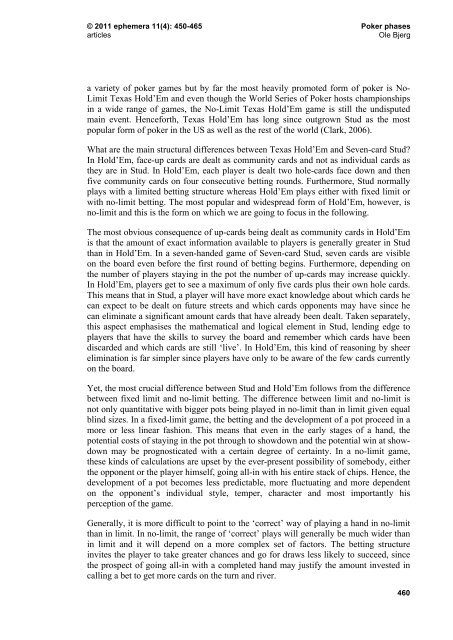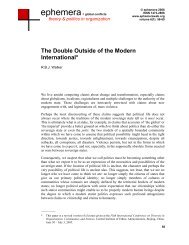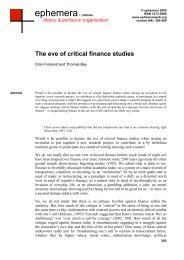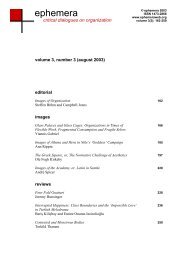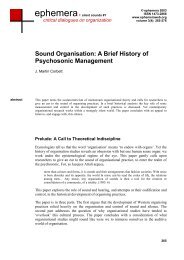Work, play and boredom - Ephemera
Work, play and boredom - Ephemera
Work, play and boredom - Ephemera
You also want an ePaper? Increase the reach of your titles
YUMPU automatically turns print PDFs into web optimized ePapers that Google loves.
© 2011 ephemera 11(4): 450-465 Poker phases<br />
articles Ole Bjerg<br />
a variety of poker games but by far the most heavily promoted form of poker is No-<br />
Limit Texas Hold’Em <strong>and</strong> even though the World Series of Poker hosts championships<br />
in a wide range of games, the No-Limit Texas Hold’Em game is still the undisputed<br />
main event. Henceforth, Texas Hold’Em has long since outgrown Stud as the most<br />
popular form of poker in the US as well as the rest of the world (Clark, 2006).<br />
What are the main structural differences between Texas Hold’Em <strong>and</strong> Seven-card Stud?<br />
In Hold’Em, face-up cards are dealt as community cards <strong>and</strong> not as individual cards as<br />
they are in Stud. In Hold’Em, each <strong>play</strong>er is dealt two hole-cards face down <strong>and</strong> then<br />
five community cards on four consecutive betting rounds. Furthermore, Stud normally<br />
<strong>play</strong>s with a limited betting structure whereas Hold’Em <strong>play</strong>s either with fixed limit or<br />
with no-limit betting. The most popular <strong>and</strong> widespread form of Hold’Em, however, is<br />
no-limit <strong>and</strong> this is the form on which we are going to focus in the following.<br />
The most obvious consequence of up-cards being dealt as community cards in Hold’Em<br />
is that the amount of exact information available to <strong>play</strong>ers is generally greater in Stud<br />
than in Hold’Em. In a seven-h<strong>and</strong>ed game of Seven-card Stud, seven cards are visible<br />
on the board even before the first round of betting begins. Furthermore, depending on<br />
the number of <strong>play</strong>ers staying in the pot the number of up-cards may increase quickly.<br />
In Hold’Em, <strong>play</strong>ers get to see a maximum of only five cards plus their own hole cards.<br />
This means that in Stud, a <strong>play</strong>er will have more exact knowledge about which cards he<br />
can expect to be dealt on future streets <strong>and</strong> which cards opponents may have since he<br />
can eliminate a significant amount cards that have already been dealt. Taken separately,<br />
this aspect emphasises the mathematical <strong>and</strong> logical element in Stud, lending edge to<br />
<strong>play</strong>ers that have the skills to survey the board <strong>and</strong> remember which cards have been<br />
discarded <strong>and</strong> which cards are still ‘live’. In Hold’Em, this kind of reasoning by sheer<br />
elimination is far simpler since <strong>play</strong>ers have only to be aware of the few cards currently<br />
on the board.<br />
Yet, the most crucial difference between Stud <strong>and</strong> Hold’Em follows from the difference<br />
between fixed limit <strong>and</strong> no-limit betting. The difference between limit <strong>and</strong> no-limit is<br />
not only quantitative with bigger pots being <strong>play</strong>ed in no-limit than in limit given equal<br />
blind sizes. In a fixed-limit game, the betting <strong>and</strong> the development of a pot proceed in a<br />
more or less linear fashion. This means that even in the early stages of a h<strong>and</strong>, the<br />
potential costs of staying in the pot through to showdown <strong>and</strong> the potential win at showdown<br />
may be prognosticated with a certain degree of certainty. In a no-limit game,<br />
these kinds of calculations are upset by the ever-present possibility of somebody, either<br />
the opponent or the <strong>play</strong>er himself, going all-in with his entire stack of chips. Hence, the<br />
development of a pot becomes less predictable, more fluctuating <strong>and</strong> more dependent<br />
on the opponent’s individual style, temper, character <strong>and</strong> most importantly his<br />
perception of the game.<br />
Generally, it is more difficult to point to the ‘correct’ way of <strong>play</strong>ing a h<strong>and</strong> in no-limit<br />
than in limit. In no-limit, the range of ‘correct’ <strong>play</strong>s will generally be much wider than<br />
in limit <strong>and</strong> it will depend on a more complex set of factors. The betting structure<br />
invites the <strong>play</strong>er to take greater chances <strong>and</strong> go for draws less likely to succeed, since<br />
the prospect of going all-in with a completed h<strong>and</strong> may justify the amount invested in<br />
calling a bet to get more cards on the turn <strong>and</strong> river.<br />
460


